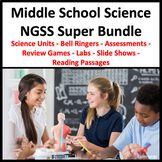Science Bell Ringers and Warm Ups for Middle School Full Year Science Review
- Zip
What educators are saying
Products in this Bundle (5)
Also included in
- This NGSS Middle School Science Bundle is my biggest bundle! It includes all my middle school science units, Bell Ringers, Jeopardy-style games, Assessments, and Informational Text Science Units for Middle School. It addresses all the NGSS standards for 6th, 7th, and 8th Grade NGSS science. Save whePrice $489.55Original Price $699.35Save $209.80
Description
Are you looking for no-prep, no-grading science bell ringers? These science bellringers and warm-ups are great for engaging students in science concepts as soon as they walk through the door. These bell ringers can be used to review science concepts quickly and as conversation starters. This bundle will save you 20% and includes Physical Science, Earth Science, Life Science, Weather and Climate, and Science Skill Review. Answer sheets in a variety of formats are included. Answers for each slide are included. With 250 science questions, this resource should last the whole year!
Benefits of My Bellringers
- easy to use
- no-prep, no grading
- helps students review and recall information
This Bell Ringer Bundle Includes:
- 50 Life Science Bell Ringers
- 50 Earth Science Bell Ringers
- 50 Physical Science Bell Ringers
- 60 Weather and Climate Bell Ringers
- Science Review
- Choice of 10 different answer sheets
- Answer Keys
- No-Grading Option
Teachers Love This Resource!❤️❤️❤️❤️
Michelle ⭐️ ⭐️ ⭐️ ⭐️ ⭐️ Extremely Satisfied
"When I am teaching science, I use these science warm-ups. The students really like the wonderful color and easy-to-follow slides. I enjoy keeping them engaged with these warm-up slides. Thanks for the wonderful resource.
Students will love these engaging science slides that help them to review previously learned information and think critically!"
Great for independent work. These warm-ups are a great way to start class each day.
See the preview for more details!
Follow me and get news of my new resources. Each new resource is discounted by 50% for the first 24 hours!
You will love my other bundles for middle school science:
Life Science Bundle
My resources are not editable for copyright reasons. These items are in pdf and ppt format.






